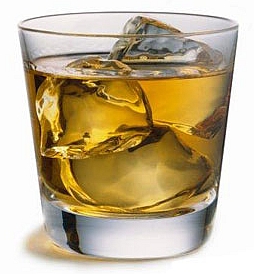Now, if you've been following my instructions, you've already watched Master Blender Richard Paterson tell you to never get it "on the rocks." The crumbly sound of a bartender reaching for ice is a terrible sound indeed. I'm going to talk about why you don't get it "on the rocks," where the hell that phrase comes from, and what you can do instead.
Firstly, look at the picture above. How much volume is taken up by the ice? Half? A Third? Shoot, it's more than necessary. Why do you want to dilute your spirit? You paid good money for that liquor, so don't bland it to death! If you ordered a fine quality Clam Chowder, don't drown it in Tabasco! And look, it's not cool to order a scotch on the rocks. Don't drink scotch because it's cool, drink it because you want to have the pleasure of drinking it. Order it "neat." That means nothing but scotch. Bartenders worth a damn will give a slight acknowledgment that, "Hey, this guy knows some stuff," and then give you a decent amount. I've never been disappointed with the amount of whisky served me when ordered neat (as opposed to ordering a rum and coke and finding it mostly coke and ice with hardly any rum).
The phrase "on the rocks" comes from an earlier Scotland. Scots would find need of cooling their drink, so they would walk to the nearest river and grab a stone (or a rock) and plop it in their drink. Ta-da! Scotch on the rocks.
But now you ask, what can I do?! There are no rivers nearby!
Chill. No, literally. You can chill your glass beforehand in the freezer. Or you can buy your own whisky rocks.
They're made of soapstone so they won't scratch you glass and do a good job of cooling your scotch. I keep a rocks glass with 4 rocks in it in my freezer at all times. Just in case. This assures that the scotch will not be diluted, but will still be chilled. Richard Paterson suggests the adding of a small amount of cold, distilled water to your whisky. When I received my Copita Nosing Glass, it came with a pipette (eye dropper thing) intended for the scientific adding of drops of water.
Now, the more important question: why? Why do you want a cold whisky? Why do you not want to dilute it? But Paterson says to do so? Well, whisky is usually bottled at 40% abv. Whisky is NOT, I repeat, NOT 40% abv naturally. Water is added before bottling in order to bring the alcoholic content down. Some whiskies bottle at what is called "Cask Strength," i.e. the abv level of the cask. Most add water to attain 40%. Paterson suggest 38% by way of adding water. What does such a small amount of water do? Well, is softens the flavors of the scotch; takes away some edges. Mostly, the harsh smokiness or saltiness is lessened and the overall palate is lighter and clearer. A Lagavulin 16 is a heavy scotch, warm, full, oily, salty, and peaty. Add a bit of water, and it becomes less peaty, less smoky, less salty, and the undertones of nuts and butter come forth. It's a way of equalizing the harsh flavors and the subtle flavors.
Same goes for temperature. A cold scotch will hit your tongue crisp! The flavors will bounce and dance on your tongue. A warm scotch will lazily sliiiiide into your throat. I like to start cold because it will always heat up, but you can't cool it with your hand. And in my experience, a warmer scotch's flavors are harder to distinguish, almost as if they meld into one complete picture. A cold scotch, to me, seems easier to pick out the individual traits.
So what have we learned?
1. Never order your scotch "on the rocks."
2. Chill a glass or some rocks to cool your drink.
3. A little bit of water is ok (and eve good), but too much (as in ice) will leave your drink weak in flavor and content.
4. If you are at a bar and really, really want a cold scotch, ask for 1, *maybe* 2 ice cubes.
As with anything scotch related, try many things! 2 drops? A spill? Ice cold? Lukewarm? No one drinks the same. I find it amazing that 1 scotch, say Cragganmore 12, can taste so vastly different utilizing temperature and water. Cragganmore is a coy, stealthy Speyside. Cold, it is dark and brooding, mellow but crisp. Warm it is buttery and viscous; sliding to and fro. Add a bit of water, and the darkness dissipates leaving a brilliant clarity of golden sunlight filled with floral notes on top of butternut almonds and smoke. My friends and I will often drink the same 3 malts first at the same time, but experiment with differing treatments. Much like our conversations. We all speak on the same topic, but we approach from different angles (Devil's advocate and whatnot). There is no right way to drink nor to speak, and the experiences are all vastly different...but we all become more enriched because of our differences. A melding of ideas and experiences enriches us all.


No comments:
Post a Comment